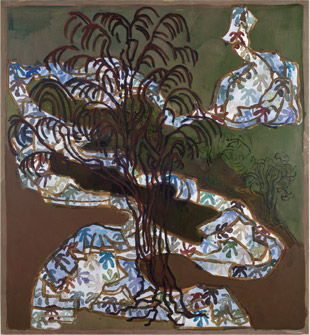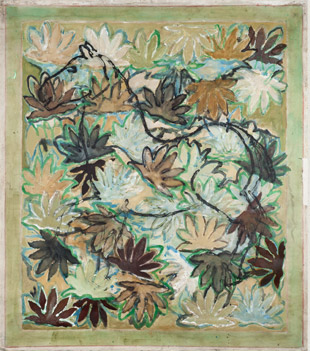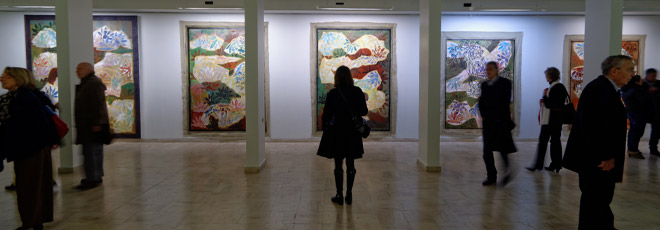The cartographical writing of Monique Tello
Alberto Manguel
It is said that forty-five centuries ago, during the reign of the Yellow Emperor, Heaven and Earth trembled and the demons and gods wept when the artist Ts’ang Chieh drew the first written ideograms on a plain piece of bark. With this gesture, Ts’ang Chieh obtained for humankind a gift that only the immortals had possessed until then. Because the written signs expressed ideas and not sounds, they could be read out in different languages as images of the things themselves, not dependent on their conventional names. In the Judeo-Christian tradition (and in that of Platonic philosophy), names are the things they name. But in the tradition begun with Ts’ang Chieh’s ideograms, things and the names of things exist independently of one another.
In Monique Tello’s paintings things are also nameless. Gracefully meandering through the space within the allotted frames, her multicoloured lines define objects, and spaces between objects, that invite, and at the same time disallow, a textual reading. Like the pages of a volume in which the writer has caused the brushstrokes to wander and the letters to unravel, her paintings, when seen sequentially, establish a series of joyful and wordless narratives. Tello’s picture-chronicles describe a world at once identifiable and until now undiscovered – a world that exists (as Mallarmé would have wished) to end in a beautiful book.
We know that the power of a metaphor can be assessed both by the degree to which it conjures up the idea at its source and by the degree to which it enriches or contaminates further ideas. The metaphor of the world as book appropriately confirms our impression that the space around us carries meaning and that every landscape tells a story; it illuminates our efforts to read narration in everything, believing that we can decipher not only the shapes and colours, but the world behind them as well. Moving in the world and deciphering words or pictures are concomitant images, evoked easily in the imagination. Both travel and reading unfold in time; both world and text define a space, whether a page, a sheet of paper, a canvas.
Monique Tello’s paintings are visions of the world, metaphors of something experienced but above all representations of something seen. Though her images cannot avoid the viewer’s impulse to read, as in Ts’ang Chieh’s writing, ambiguous narratives and intricate cartographies, the overall impression is that of a natural world dutifully reported by the artist. They are the faithful exposition of something existing in stone and flesh, translated now into an interwoven progression of lines and repeated shapes, like a path through a pattern of ancient wallpaper, or rather like the writing in a book in a script not yet decoded, or like maps of a jungle landscape that refuses the two-dimensional conventions of map-making, The various similes overlap.
Tello’s work effectively creates a unfurled scroll of images that stand, in the viewer’s eye, for the world itself or, at least, for the artist’s vision of the natural world, so that, each time a comparison is conjured up, it proves partial or ineffective. In this sense, her paintings incarnate the ancient book-world metaphor in all its kaleidoscopic richness.
© 2013, Alienor.org, Conseil des musées


